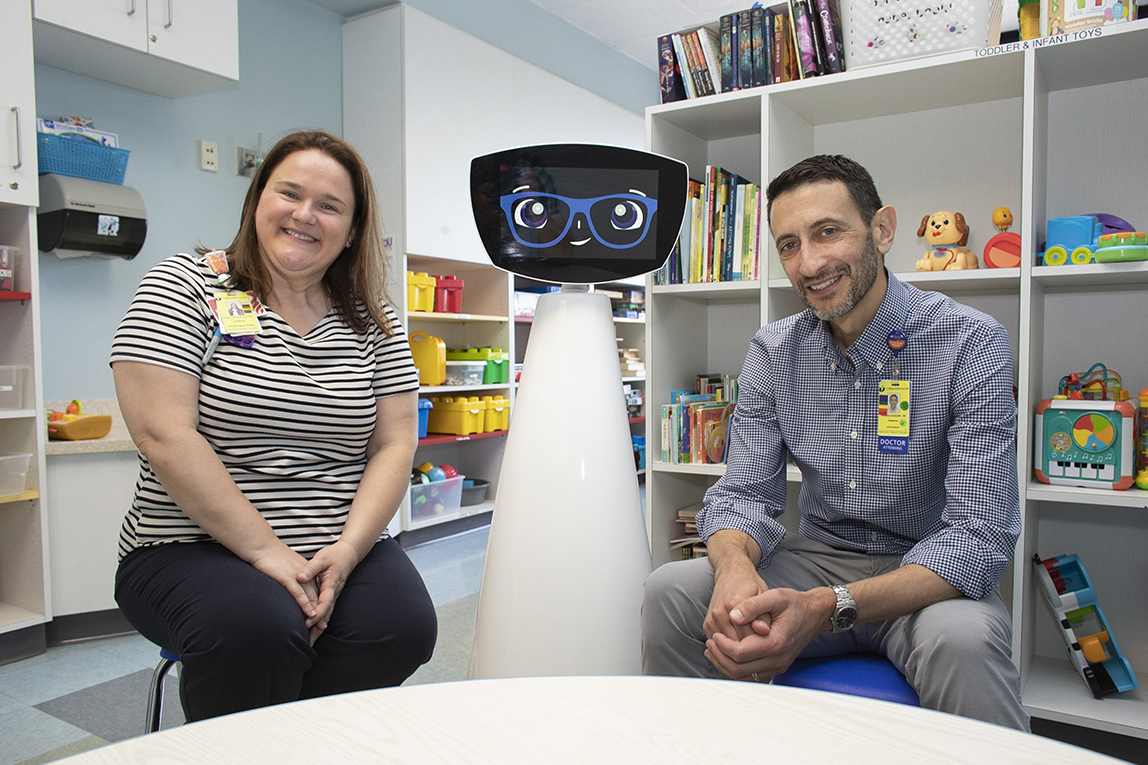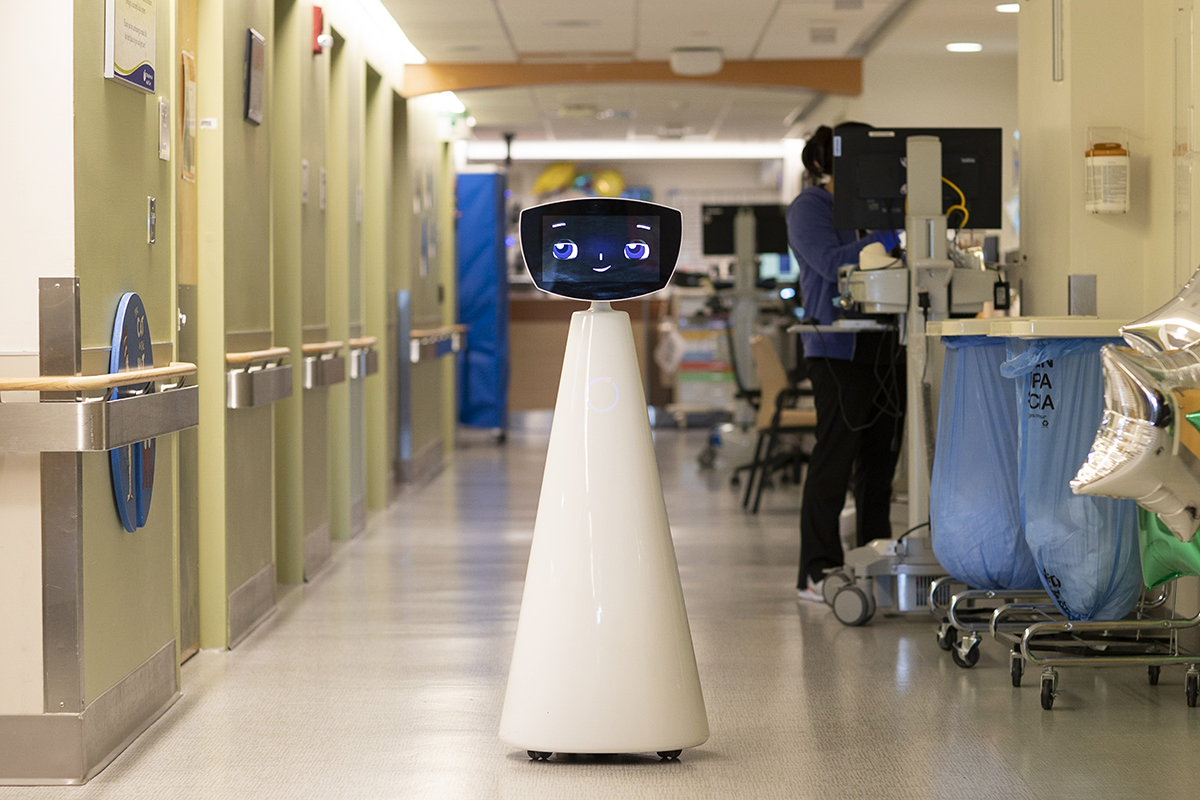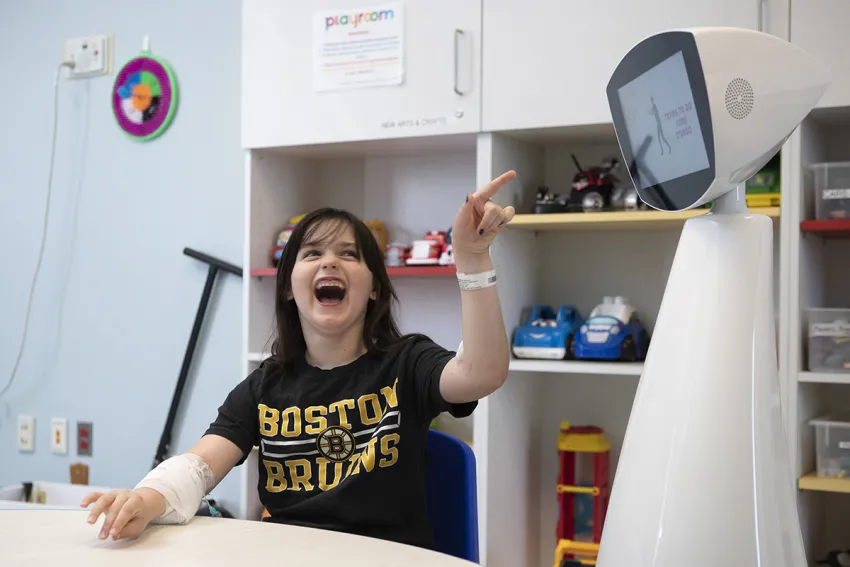Photo above: Catherine, a pediatric patient at UMass Memorial Medical Center – Children’s Medical Center, enjoys playing a game with Robin the Robot (Photo credit: Matt Wright).
A young boy stands next to his IV pole in the playroom at UMass Memorial Medical Center – Children’s Medical Center. Holding his mother’s hand, the boy slowly approaches a 4-foot-tall robot with big, blinking eyes.
A smile peeks out from behind the boy’s blue mask as he walks closer, waves his hand and says, “Hi.” Soon, the boy and his mom are interacting with the robot, jumping up and down, dancing, playing games and laughing.
Meet Robin the Robot
The robot is named Robin, and this incredible technology is changing how physicians and Child Life specialists deliver care to pediatric patients. UMass Memorial Medical Center – Children’s Medical Center is the first children’s hospital on the East Coast — and one of only three hospitals in the nation — to have one of these human-assisted, artificially intelligent robots designed specifically for children in a hospital setting.
“Robin can interact with kids in a unique way that humans cannot,” said Thomas Guggina, MD, pediatric hospitalist at UMass Memorial Medical Center and Assistant Professor of Pediatrics at UMass Chan Medical School. “When a child is hospitalized, there’s so much uncertainty. They’re particularly vulnerable to fear of the unknown. On top of that, they may be dealing with pain or physical distress. But then a robot comes in, bringing an element of surprise. The kids just light up when they see Robin.”
An Award-Winning Invention
In March 2022, Kendra Frederick, Child Life Manager at the Children’s Medical Center, received an email from a colleague asking if she’d heard about a robot named Robin. The email, from Susan Mouradian, Senior Director of Leadership and Institutional Philanthropy at UMass Memorial Health, said: “This is one of Time magazine’s 100 Best Inventions of 2021. Have you ever heard of it?”
“Her email was really timely,” said Frederick. “We were still battling the COVID-19 pandemic, and we were thinking about the practices of Child Life very differently. We had record numbers of kids, and they were isolated in rooms for longer than we had ever seen.”
Before the pandemic, Frederick says the inpatient unit at the Children’s Medical Center was bustling with interactions among patients, family members and staff. “Kids walked in the hallways and attended music groups and playgroups with other kids in the playroom. Families in the waiting rooms engaged with one another. There was a level of community and support in helping kids realize they aren't alone in their medical journey. And all that came to a screeching halt in 2020,” she said. “We had to develop a new approach to how we provide care.”

At the Forefront of Innovative Technology
That approach now includes a sleek, white robot with a calming, childlike voice and the personality of a 7-year-old. Robin the Robot was created by Expper Technologies, a health-tech company based in Armenia. The team at Expper designed Robin to be approachable and friendly, using “peer-to-peer interaction” to comfort and distract children in a hospital setting.
Primarily voice-activated, Robin’s capabilities include everything from having a conversation and playing games to reading a book and telling jokes. Robin understands a wide range of questions, responses, requests and commands. If a patient is scheduled to have a test or procedure, Robin provides age-appropriate patient education, explaining an X-ray, MRI and other medical procedures with images that appear on the robot’s screen.
“Robin responds and adapts to the child’s imagination, so each interaction is different. The possibilities are endless,” said Frederick. A camera inside Robin’s screen allows the robot to see a child’s facial expressions, and the robot can even respond in real time. Robin may celebrate with a kid who just completed treatment or help calm an anxious child using breathing exercises, soothing music or pictures of a favorite animal.
Decoding an Unfamiliar Environment
The pediatric inpatient unit at UMass Memorial cares for patients 21 and under who have various physical and mental health concerns. “Because it’s a general medicine unit, there are many varied diagnoses and patients of different ages,” said Frederick. “We use Robin on a lot of different levels. I’ve had Robin play with toddlers, and I've had Robin engage with teenagers.”
Children are admitted for a wide range of conditions, from acute infections or injuries to chronic illnesses like cancer or diabetes. They may be admitted for chemotherapy, surgery or because they’ve experienced trauma. Many patients are admitted following a mental health crisis or suicide attempt.
“Kids come to the hospital, and they’re scared, vulnerable or in pain — sometimes mentally and physically,” said Frederick.” Interacting with Robin makes them feel like they're not alone. And that helps kids cope with being here for a long time or having to do hard things.”
Some kids ask Robin to have a dance party or play an interactive game. Others may want to talk or just sit quietly and listen to Robin play music. “We’ve found that patients can open up to Robin in a very special way,” said Guggina. “Kids feel comfortable confiding in Robin and expressing feelings or concerns that they may be too insecure to share with a family member or a member of the care team.”
Built for a Medical Setting, With Patients in Mind
Robin’s “home” is in the playroom, and anyone can interact with the robot in that space, but Robin also visits patients in their rooms. Physicians and other providers, nurses and Child Life specialists determine who might benefit from a visit, and they work together to prioritize who Robin sees. Most often, Robin checks in on children who have been in the hospital for a while and those who are in isolation due to an immune disorder or infection.
“Robin is infection-control compliant and easy to sanitize. We can use Robin in isolation rooms where we can’t use board games or books,” said Frederick. Since the robot is voice-controlled, there’s no need to touch the screen or move Robin around. When told, “Hey, Robin, come with me,” the robot follows the staff member, gliding down the hallway on little wheels.
Robin is also HIPAA-compliant. “During interactions with patients, nothing is recorded,” said Frederick. “We consulted with our IT specialists and corporate compliance department to make sure it was safe for Robin to interact with our patients and families.”

Giving Kids Autonomy in an Unpredictable Setting
“Kids don't have a lot of autonomy in a hospital. They don’t get to choose who comes in their room or which procedures to have,” said Frederick. “One of the magical things about Robin is that the kids are in control. With Robin, the kids decide if they want to play, what the activity is and when the interaction starts and stops. It's a wonderful opportunity for kids to be in the driver's seat.”
Robin has the unique ability to meet patients where they are. Having Robin on the team has empowered kids to open up on their own terms. “During the pandemic, we had many patients who were so despondent, and they were with us for a very long time,” said Guggina. “One patient was so sad and not particularly expressive with staff. The interactions with Robin really helped this patient. Knowing that we had Robin to deploy and bring some joy to this patient’s day was really wonderful.”
Increasing Accessibility
Robin is fluent in English and Armenian and understands several other languages, including Spanish. Expper Technologies frequently adds to Robin’s capabilities. Several times a month, Frederick contacts the Expper team to check in and suggest new content. Around the winter holidays, Frederick asked the team to add Hanukkah images and songs. The Expper team responded right away, adding the content to Robin’s repertoire so the robot could make meaningful connections with more patients.
One day, Frederick entered the playroom and happened upon an interaction that stopped her in her tracks. “There was a patient who was nonverbal. To communicate, this boy used an app on his iPad that had simple words and pictures,” said Frederick. “Robin was asking him things like, ‘What's your favorite food?’”
Using the camera on Robin’s screen, the robot could see what was appearing on the boy’s iPad. Frederick watched and listened as the boy and the robot had an entire conversation, communicating with each other in their own ways. “At one point, the boy was getting frustrated that his communication was slow, and Robin encouraged him, saying, “’It's OK, you're doing a great job. I will be patient. Don't rush,’” said Frederick. “It was a beautiful example of the power of technology.”
Interacting With Technology, Safely
The UMass Memorial Health team established parameters to ensure children balance technology with other essential activities. Robin is only available from 10 a.m. to 4 p.m. If a child asks to see Robin outside those times, staff members explain that Robin needs to take a break and recharge during rest hours, just like humans.
They set these boundaries to avoid mealtimes and visiting hours, allow kids to get a good night’s sleep and encourage them to enjoy other activities. “We want kids to come to the playroom and engage with open-ended art materials, play with toys, read books and interact with their parents and siblings,” said Frederick. In addition, rounds typically happen in the morning, so the team limits Robin’s hours to encourage kids to participate in their care without distractions.
Proven Benefits for Patients and Staff
The Expper team has conducted formal studies on Robin’s many benefits. According to Expper, its studies show a noticeable increase in joy and reduced stress and anxiety in children who interacted with Robin, as well as improvements in patient satisfaction rates and the overall patient and family experience.
Robin brings joy to staff members, too. Frederick and Guggina agree that seeing Robin interact with a patient is a wonderful experience. “I've seen kids who had been hospitalized for weeks and were very sick,” said Guggina. “And as they're regaining their strength, they’re interacting with Robin and asking Robin to tell jokes or play a song, and then they sing along. The joy that comes from that is really special.”
Frederick emphasizes the “incredible impact” Robin’s presence has had on her team. She points out that the interactions are especially beneficial to doctors and nurses who care for kids who are struggling. “To see the kids enjoy a moment of positivity, joy and normalcy has an immediate ripple effect on the staff. We’re lucky to have Robin and to receive the necessary funding through grants and donations.”
Helping Children Heal
Guggina and Frederick agree that the robot’s capabilities are multifaceted. From a clinical standpoint, Robin has helped children use their muscles, gain strength and speed healing. “Robin is providing tools we can use to help kids recover,” said Guggina.
Robin encourages kids to engage in physical therapy and speech therapy and reach important milestones by motivating them in a way only a robot can. “We had one patient who was in a serious car accident and had a lot of trouble ambulating after surgery,” said Frederick. “It was a magical moment to see that child walk down to the playroom with a walker because he wanted to meet Robin. Getting that child up and out of bed was certainly a goal for physical therapy.”
As an important member of the health care team, Robin has a unique ability to connect with children. “Robin was interacting with a young girl who had complex palate surgery,” said Guggina. “Robin would play a clip from ‘Moana,’ and the girl would sing along, which engaged her palate in a way that was helpful to her recovery.”
Heading Home Sooner
Robin was also instrumental in helping a young patient go home after surgery. “We partnered with nursing and nutrition to help a patient who needed to improve her oral intake in order to go home,” said Frederick. The child was very nervous about eating and drinking and didn’t want to consume anything.
Robin visited the child, playing games and interacting. Every few minutes, Robin would stop the game and say, “It's time to take another sip.” An image of a smoothie appeared on Robin’s screen, and they would take sips together. After about 45 minutes, the child had met the oral intake requirements and could go home.
Changing Their Approach to Care
UMass Memorial is known for its focus on innovation, and welcoming Robin to the team reflects that focus. “We are constantly looking for ways to improve patient care, provide access to care and think about our care differently,” said Frederick. “This is the perfect way to do that using life-changing technology. With Robin, we are using something new, exciting and different to help our patients.”
Both Frederick and Guggina say Robin has impacted their perspective when caring for patients. Having Robin on the team reminds them to remain open to new possibilities, just as the kids are open to Robin. “This experience underscores the importance of bringing joy to the practice of caring for kids who are sick,” said Guggina. “That element of surprise — and the joy that comes with that — really helps patients get better.”


